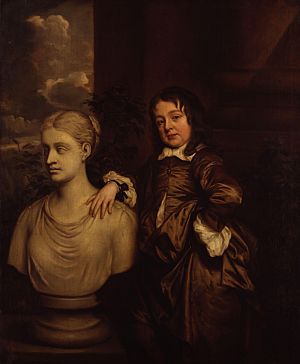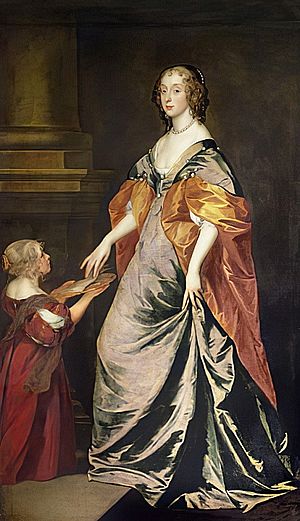Richard Gibson (painter) facts for kids
Quick facts for kids
Richard Gibson
|
|
|---|---|

A portrait of Gibson with a classical bust, painted by Peter Lely
|
|
| Born | 1615 |
| Died | July 23, 1690 |
| Nationality | English |
| Known for | Painting |
Richard Gibson (1615-1690) was a talented English painter. He was famous for his tiny, detailed pictures called portrait miniatures. People often called him "Dwarf Gibson" because he was very short. He worked for several English kings and queens, including King Charles I, King Charles II, and King William III and Queen Mary II. He even worked during the time of Oliver Cromwell, who ruled England for a while.
Two famous poets, Andrew Marvell and Edmund Waller, wrote poems about him!
Contents
Richard Gibson's Life and Art
Early Life and Training
We don't know much about Richard Gibson's very early life. But it's said he worked as a helper for a lady in a place called Mortlake. This lady noticed he was very good at art. She helped him study painting with Francis Cleyn, who was in charge of designs at the Mortlake Tapestry Works.
In the 1630s, Gibson started working for Philip Herbert, 4th Earl of Pembroke. Pembroke was a very important person in the king's court. People called Gibson "little Dick, my lord Chamberlain's page." He copied many paintings from royal and noble collections. He also started painting his own original portraits for rich clients. Pembroke was a big supporter of Gibson's art. He might have even introduced Gibson to Peter Lely, another famous painter. Gibson and Lely became good friends and worked together often. Lely even painted several pictures of Gibson.
Working for Kings and Queens
Richard Gibson became a "Page of the Back Stairs" for King Charles I. This was an important job in the royal household. During the English Civil War, Gibson stayed in London with Pembroke. This meant he was on the side of the Parliament, not the King.
Even after the war, in the 1650s, Gibson kept painting. He worked for important people, even during Oliver Cromwell's rule. His connections to Cromwell did not stop his career when King Charles II came back to power.
King Charles II hired Gibson to teach drawing to his nieces, Princess Mary and Princess Anne. Princess Mary later became Queen Mary II. Gibson even traveled with Princess Mary to the Netherlands when she married William of Orange in 1677. He returned to England in 1688 when William and Mary became the new King and Queen.
Richard Gibson's Family

Richard Gibson married Anne Shepherd. She was also very short and was known as the "queen's dwarf" because she worked for Queen Henrietta Maria. Both Richard and Anne were about 3 feet 10 inches tall.
Their wedding was a special event held at the royal court. King Charles I himself walked Anne down the aisle! The poet Edmund Waller wrote a poem about their wedding. He said they were perfectly made for each other.
Richard and Anne had nine children together. Interestingly, all their children were of typical height. Three of their children became successful painters, just like their father. The most famous was their daughter, Susan. She became a well-known miniature painter, using her married name, Susan Penelope Rosse.
Gibson's Painting Style
Richard Gibson's miniature paintings have a special look. Art experts say his work has "thick paint and parallel lines." This gives his paintings a textured feel, almost like oil paintings. His colors were often soft and gentle.
By the 1650s, Gibson was so busy that he might have had helpers. This is suggested by some paintings that look like his style but aren't quite as good. His own children might have learned their painting skills by helping him. He also started using brighter colors around this time, which was popular with the new King Charles II's court.
Art historians John Murdoch and V. J. Murrell say that a key part of Gibson's style is the "diagonal lines in the skin painting." They describe how you can see the brush strokes, especially on foreheads and under the chin. These lines often go downwards from right to left. This way of painting was different from older miniature artists who used more transparent colors. Gibson's style was more like oil painting. This shows he was likely influenced by his friend, the famous painter Peter Lely.
See also
- William Gibson (painter)
- Edward Gibson (painter)

